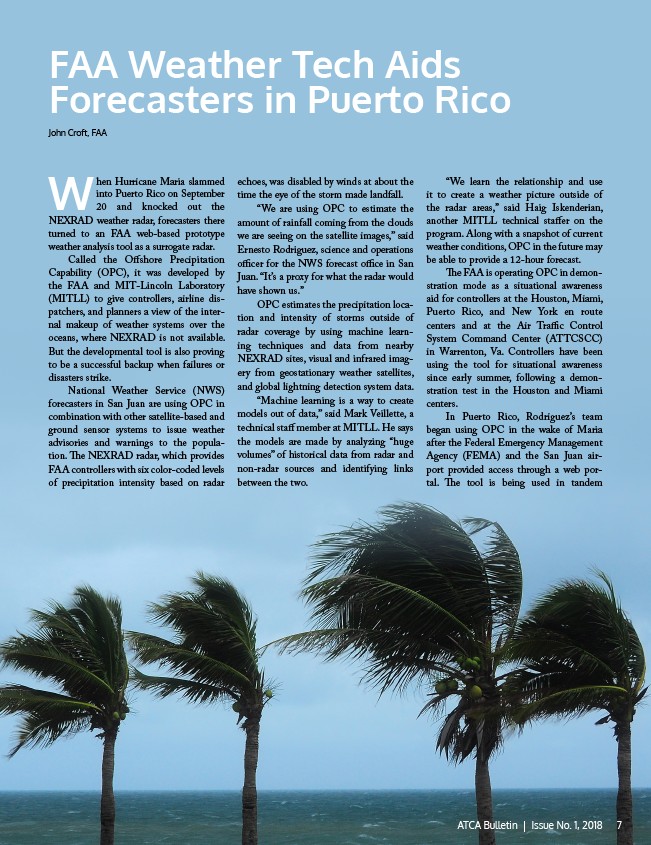
FAA Weather Tech Aids
Forecasters in Puerto Rico
John Croft, FAA
When Hurricane Maria slammed
into Puerto Rico on September
20 and knocked out the
NEXRAD weather radar, forecasters there
turned to an FAA web-based prototype
weather analysis tool as a surrogate radar.
Called the Offshore Precipitation
Capability (OPC), it was developed by
the FAA and MIT-Lincoln Laboratory
(MITLL) to give controllers, airline dis-patchers,
and planners a view of the inter-nal
makeup of weather systems over the
oceans, where NEXRAD is not available.
But the developmental tool is also proving
to be a successful backup when failures or
disasters strike.
National Weather Service (NWS)
forecasters in San Juan are using OPC in
combination with other satellite-based and
ground sensor systems to issue weather
advisories and warnings to the popula-tion.
The NEXRAD radar, which provides
FAA controllers with six color-coded levels
of precipitation intensity based on radar
echoes, was disabled by winds at about the
time the eye of the storm made landfall.
“We are using OPC to estimate the
amount of rainfall coming from the clouds
we are seeing on the satellite images,” said
Ernesto Rodriguez, science and operations
officer for the NWS forecast office in San
Juan. “It’s a proxy for what the radar would
have shown us.”
OPC estimates the precipitation loca-tion
and intensity of storms outside of
radar coverage by using machine learn-ing
techniques and data from nearby
NEXRAD sites, visual and infrared imag-ery
from geostationary weather satellites,
and global lightning detection system data.
“Machine learning is a way to create
models out of data,” said Mark Veillette, a
technical staff member at MITLL. He says
the models are made by analyzing “huge
volumes” of historical data from radar and
non-radar sources and identifying links
between the two.
“We learn the relationship and use
it to create a weather picture outside of
the radar areas,” said Haig Iskenderian,
another MITLL technical staffer on the
program. Along with a snapshot of current
weather conditions, OPC in the future may
be able to provide a 12-hour forecast.
The FAA is operating OPC in demon-stration
mode as a situational awareness
aid for controllers at the Houston, Miami,
Puerto Rico, and New York en route
centers and at the Air Traffic Control
System Command Center (ATTCSCC)
in Warrenton, Va. Controllers have been
using the tool for situational awareness
since early summer, following a demon-stration
test in the Houston and Miami
centers.
In Puerto Rico, Rodriguez’s team
began using OPC in the wake of Maria
after the Federal Emergency Management
Agency (FEMA) and the San Juan air-port
provided access through a web por-tal.
The tool is being used in tandem
ATCA Bulletin | Issue No. 1, 2018 7